Simplifying School Enrolment Experience with SAFApplicant
Enhances the application experience for parents, applicants, and schools, while improving accessibility and delivering a seamless process.
Company
FLexiSAF Edusoft
FLexiSAF Edusoft
Duration
2 Weeks
Tools
Adobe XD, Figma, Hotjar, Log Rocket, React, Lucid Charts, Miro
Team
Designer
2 Front end developers
2 backend developer
1 Product Manager
Product Owner
3 Customer success agents
Core Responsibilities
User Research
User Testing
Design system Development
Component Development in React
Prototyping
Strategy Analysis
Design conversion



30% Higher Completion Rate
Streamlined process boosted applications.
25% Faster Application Time
Modular forms sped up completion.
90% Positive User Satisfaction
Simplified steps delighted applicants.
Project Overview
SAFApply is an innovative Edtech solution designed to streamline applicant's application process to educational institutions. Targeting high school students and their parents and guardians, SAFApply aims to simplify the complex and often overwhelming application process by providing a user-friendly platform that guides users through each step.
Project Overview
SAFApply is an innovative Edtech solution designed to streamline applicant's application process to educational institutions. Targeting high school students and their parents and guardians, SAFApply aims to simplify the complex and often overwhelming application process by providing a user-friendly platform that guides users through each step.
Project Overview
SAFApply is an innovative Edtech solution designed to streamline applicant's application process to educational institutions. Targeting high school students and their parents and guardians, SAFApply aims to simplify the complex and often overwhelming application process by providing a user-friendly platform that guides users through each step.
Project Overview
SAFApply is an innovative Edtech solution designed to streamline applicant's application process to educational institutions. Targeting high school students and their parents and guardians, SAFApply aims to simplify the complex and often overwhelming application process by providing a user-friendly platform that guides users through each step.
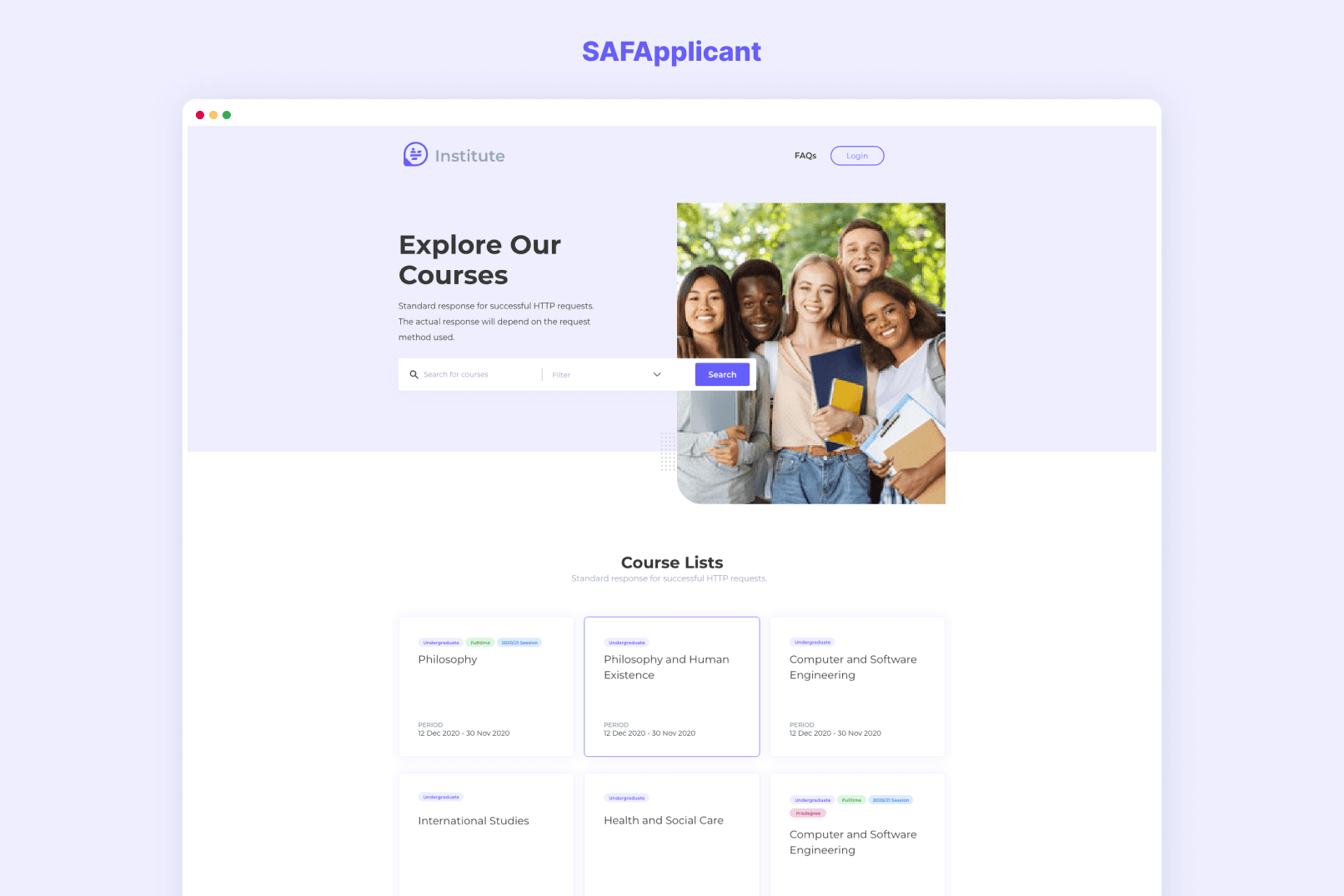


The Challenge
SAFApplicant was designed to simplify the course and program application process for academic institutions. However, many applicants and their families faced notable obstacles along the way, including:
Inaccessible Course Information
56% of institutions lacked accessible course details for prospective applicants.
Confusing Instructions
Admission instructions were often unclear, leading to frequent mistakes and incomplete applications.
Lack of Guidance
Applicants needed more support throughout the process, often feeling lost and unsure of their next steps.
Lengthy Application Process
Traditional applications were time-consuming, requiring significant effort to complete.
The Challenge
SAFApplicant was designed to simplify the course and program application process for academic institutions. However, many applicants and their families faced notable obstacles along the way, including:
Inaccessible Course Information
56% of institutions lacked accessible course details for prospective applicants.
Confusing Instructions
Admission instructions were often unclear, leading to frequent mistakes and incomplete applications.
Lack of Guidance
Applicants needed more support throughout the process, often feeling lost and unsure of their next steps.
Lengthy Application Process
Traditional applications were time-consuming, requiring significant effort to complete.
The Challenge
SAFApplicant was designed to simplify the course and program application process for academic institutions. However, many applicants and their families faced notable obstacles along the way, including:
Inaccessible Course Information
56% of institutions lacked accessible course details for prospective applicants.
Confusing Instructions
Admission instructions were often unclear, leading to frequent mistakes and incomplete applications.
Lack of Guidance
Applicants needed more support throughout the process, often feeling lost and unsure of their next steps.
Lengthy Application Process
Traditional applications were time-consuming, requiring significant effort to complete.
The Challenge
SAFApplicant was designed to simplify the course and program application process for academic institutions. However, many applicants and their families faced notable obstacles along the way, including:
Inaccessible Course Information
56% of institutions lacked accessible course details for prospective applicants.
Confusing Instructions
Admission instructions were often unclear, leading to frequent mistakes and incomplete applications.
Lack of Guidance
Applicants needed more support throughout the process, often feeling lost and unsure of their next steps.
Lengthy Application Process
Traditional applications were time-consuming, requiring significant effort to complete.
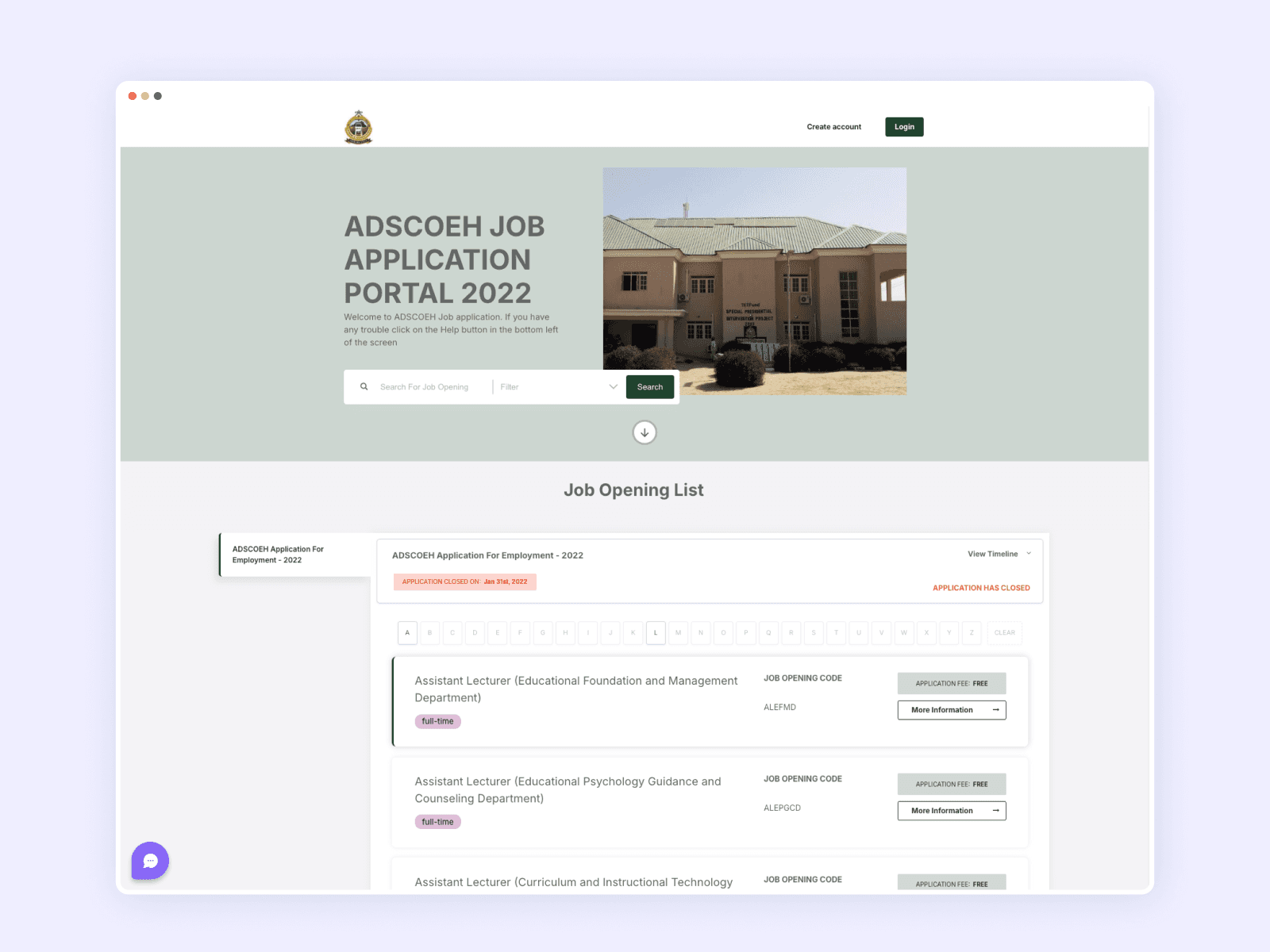


Project Goal
The primary goals were to improve the user experience of the application process, increase the completion rate of applications, and enhance overall user satisfaction. Specific metrics for success included;
reducing the average time to complete an application,
increasing the user adoption rate, and
achieving high satisfaction scores from both students and parents/guardian.
Project Goal
The primary goals were to improve the user experience of the application process, increase the completion rate of applications, and enhance overall user satisfaction. Specific metrics for success included;
reducing the average time to complete an application,
increasing the user adoption rate, and
achieving high satisfaction scores from both students and parents/guardian.
Project Goal
The primary goals were to improve the user experience of the application process, increase the completion rate of applications, and enhance overall user satisfaction. Specific metrics for success included;
reducing the average time to complete an application,
increasing the user adoption rate, and
achieving high satisfaction scores from both students and parents/guardian.
Project Goal
The primary goals were to improve the user experience of the application process, increase the completion rate of applications, and enhance overall user satisfaction. Specific metrics for success included;
reducing the average time to complete an application,
increasing the user adoption rate, and
achieving high satisfaction scores from both students and parents/guardian.
Design Approach
The SAFApplicant project involved several key phases, including user research, ideation, prototyping, design, development, and launch. The main deliverables included a comprehensive user interface, an integration with the design system, and a fully functional application platform. Our milestones included completing user research, developing wireframes and prototypes, conducting usability tests, and launching the final product.

Research Objectives
The main research objectives were to;
Understanding User Needs
To identify the challenges and pain points experienced by students and parents during the educational application process.
Validating Assumptions
To validate assumptions about the needs and preferences of schools and parents.
Informing Design Decisions
To gather insights that would inform the design and development of SAFApply, ensuring it meets user needs effectively.
Methodology
While I needed move fast within the available timeline, the team was quite limited time, so surveyed the applicants and and interviewed some of the parents to gather some qualitative and quantitative feedback.

Survey
I conducted an online survey with 300 high school and tertiary institution applicants and existing students, the survey also included 50 parents to gather quantitative data in their experiences and preferences.
50% of the students surveyed we high school students, this was to understand the current challenges while applying to universities they wanted to study.
The other 50% of the student were newly admitted students who had first experience during the admission procession thus providing the opportunity to discover what they liked and disliked about the admission process and what they would want to change about it.
Interview
Held in-depth interviews with 10 parents and representatives from 5 schools to gain qualitative insights into their pain points and expectations.
Participant Details



Key Findings and Insights
Parents
Found the process of finding and applying to schools time-consuming and difficult.
Preferred visiting schools and discussing with the admissions office before making decisions.
Desired more online information about schools, as current online presence was often inadequate.
Preferred paying application fees after their child passed the admission test.
60% of parents found the application process difficult and time-consuming.
Only 25% of parents were satisfied with the current enrollment process, highlighting a significant opportunity for improvement.
Applicants/Students from Schools
Schools charged between 2,000 and 15,000 naira for application forms.
65% were paper forms which applicants would have to fill this form and return back to the school with physical copies of other documents required for the processing.
28% had an online form where applicants can upload the completed forms with the teller/receipt of payment for the admission with other documents as requested for the admission.
Preferred physical visits before application for 1:1 discussions.
Advertised mainly through traditional media and digital platforms.
Highlighted challenges with paper forms and the need for digital record-keeping.
Opportunities Identified for Impact
Simplified Instructions
The need for instruction flow to be more intuitive and easy to understand, addressing the confusion faced by users.
Enhanced Guidance
Step-by-step guide and contextual help to assist users at each stage of the application process.
Streamlined Process
Proper Indication the number of steps required to complete an application and ability to save the form and continue where they left of
Design Approach
The SAFApplicant project involved several key phases, including user research, ideation, prototyping, design, development, and launch. The main deliverables included a comprehensive user interface, an integration with the design system, and a fully functional application platform. Our milestones included completing user research, developing wireframes and prototypes, conducting usability tests, and launching the final product.

Research Objectives
The main research objectives were to;
Understanding User Needs
To identify the challenges and pain points experienced by students and parents during the educational application process.
Validating Assumptions
To validate assumptions about the needs and preferences of schools and parents.
Informing Design Decisions
To gather insights that would inform the design and development of SAFApply, ensuring it meets user needs effectively.
Methodology
While I needed move fast within the available timeline, the team was quite limited time, so surveyed the applicants and and interviewed some of the parents to gather some qualitative and quantitative feedback.

Survey
I conducted an online survey with 300 high school and tertiary institution applicants and existing students, the survey also included 50 parents to gather quantitative data in their experiences and preferences.
50% of the students surveyed we high school students, this was to understand the current challenges while applying to universities they wanted to study.
The other 50% of the student were newly admitted students who had first experience during the admission procession thus providing the opportunity to discover what they liked and disliked about the admission process and what they would want to change about it.
Interview
Held in-depth interviews with 10 parents and representatives from 5 schools to gain qualitative insights into their pain points and expectations.
Participant Details



Key Findings and Insights
Parents
Found the process of finding and applying to schools time-consuming and difficult.
Preferred visiting schools and discussing with the admissions office before making decisions.
Desired more online information about schools, as current online presence was often inadequate.
Preferred paying application fees after their child passed the admission test.
60% of parents found the application process difficult and time-consuming.
Only 25% of parents were satisfied with the current enrollment process, highlighting a significant opportunity for improvement.
Applicants/Students from Schools
Schools charged between 2,000 and 15,000 naira for application forms.
65% were paper forms which applicants would have to fill this form and return back to the school with physical copies of other documents required for the processing.
28% had an online form where applicants can upload the completed forms with the teller/receipt of payment for the admission with other documents as requested for the admission.
Preferred physical visits before application for 1:1 discussions.
Advertised mainly through traditional media and digital platforms.
Highlighted challenges with paper forms and the need for digital record-keeping.
Opportunities Identified for Impact
Simplified Instructions
The need for instruction flow to be more intuitive and easy to understand, addressing the confusion faced by users.
Enhanced Guidance
Step-by-step guide and contextual help to assist users at each stage of the application process.
Streamlined Process
Proper Indication the number of steps required to complete an application and ability to save the form and continue where they left of
Design Approach
The SAFApplicant project involved several key phases, including user research, ideation, prototyping, design, development, and launch. The main deliverables included a comprehensive user interface, an integration with the design system, and a fully functional application platform. Our milestones included completing user research, developing wireframes and prototypes, conducting usability tests, and launching the final product.

Research Objectives
The main research objectives were to;
Understanding User Needs
To identify the challenges and pain points experienced by students and parents during the educational application process.
Validating Assumptions
To validate assumptions about the needs and preferences of schools and parents.
Informing Design Decisions
To gather insights that would inform the design and development of SAFApply, ensuring it meets user needs effectively.
Methodology
While I needed move fast within the available timeline, the team was quite limited time, so surveyed the applicants and and interviewed some of the parents to gather some qualitative and quantitative feedback.

Survey
I conducted an online survey with 300 high school and tertiary institution applicants and existing students, the survey also included 50 parents to gather quantitative data in their experiences and preferences.
50% of the students surveyed we high school students, this was to understand the current challenges while applying to universities they wanted to study.
The other 50% of the student were newly admitted students who had first experience during the admission procession thus providing the opportunity to discover what they liked and disliked about the admission process and what they would want to change about it.
Interview
Held in-depth interviews with 10 parents and representatives from 5 schools to gain qualitative insights into their pain points and expectations.
Participant Details



Key Findings and Insights
Parents
Found the process of finding and applying to schools time-consuming and difficult.
Preferred visiting schools and discussing with the admissions office before making decisions.
Desired more online information about schools, as current online presence was often inadequate.
Preferred paying application fees after their child passed the admission test.
60% of parents found the application process difficult and time-consuming.
Only 25% of parents were satisfied with the current enrollment process, highlighting a significant opportunity for improvement.
Applicants/Students from Schools
Schools charged between 2,000 and 15,000 naira for application forms.
65% were paper forms which applicants would have to fill this form and return back to the school with physical copies of other documents required for the processing.
28% had an online form where applicants can upload the completed forms with the teller/receipt of payment for the admission with other documents as requested for the admission.
Preferred physical visits before application for 1:1 discussions.
Advertised mainly through traditional media and digital platforms.
Highlighted challenges with paper forms and the need for digital record-keeping.
Opportunities Identified for Impact
Simplified Instructions
The need for instruction flow to be more intuitive and easy to understand, addressing the confusion faced by users.
Enhanced Guidance
Step-by-step guide and contextual help to assist users at each stage of the application process.
Streamlined Process
Proper Indication the number of steps required to complete an application and ability to save the form and continue where they left of
Design Approach
The SAFApplicant project involved several key phases, including user research, ideation, prototyping, design, development, and launch. The main deliverables included a comprehensive user interface, an integration with the design system, and a fully functional application platform. Our milestones included completing user research, developing wireframes and prototypes, conducting usability tests, and launching the final product.

Research Objectives
The main research objectives were to;
Understanding User Needs
To identify the challenges and pain points experienced by students and parents during the educational application process.
Validating Assumptions
To validate assumptions about the needs and preferences of schools and parents.
Informing Design Decisions
To gather insights that would inform the design and development of SAFApply, ensuring it meets user needs effectively.
Methodology
While I needed move fast within the available timeline, the team was quite limited time, so surveyed the applicants and and interviewed some of the parents to gather some qualitative and quantitative feedback.

Survey
I conducted an online survey with 300 high school and tertiary institution applicants and existing students, the survey also included 50 parents to gather quantitative data in their experiences and preferences.
50% of the students surveyed we high school students, this was to understand the current challenges while applying to universities they wanted to study.
The other 50% of the student were newly admitted students who had first experience during the admission procession thus providing the opportunity to discover what they liked and disliked about the admission process and what they would want to change about it.
Interview
Held in-depth interviews with 10 parents and representatives from 5 schools to gain qualitative insights into their pain points and expectations.
Participant Details



Key Findings and Insights
Parents
Found the process of finding and applying to schools time-consuming and difficult.
Preferred visiting schools and discussing with the admissions office before making decisions.
Desired more online information about schools, as current online presence was often inadequate.
Preferred paying application fees after their child passed the admission test.
60% of parents found the application process difficult and time-consuming.
Only 25% of parents were satisfied with the current enrollment process, highlighting a significant opportunity for improvement.
Applicants/Students from Schools
Schools charged between 2,000 and 15,000 naira for application forms.
65% were paper forms which applicants would have to fill this form and return back to the school with physical copies of other documents required for the processing.
28% had an online form where applicants can upload the completed forms with the teller/receipt of payment for the admission with other documents as requested for the admission.
Preferred physical visits before application for 1:1 discussions.
Advertised mainly through traditional media and digital platforms.
Highlighted challenges with paper forms and the need for digital record-keeping.
Opportunities Identified for Impact
Simplified Instructions
The need for instruction flow to be more intuitive and easy to understand, addressing the confusion faced by users.
Enhanced Guidance
Step-by-step guide and contextual help to assist users at each stage of the application process.
Streamlined Process
Proper Indication the number of steps required to complete an application and ability to save the form and continue where they left of
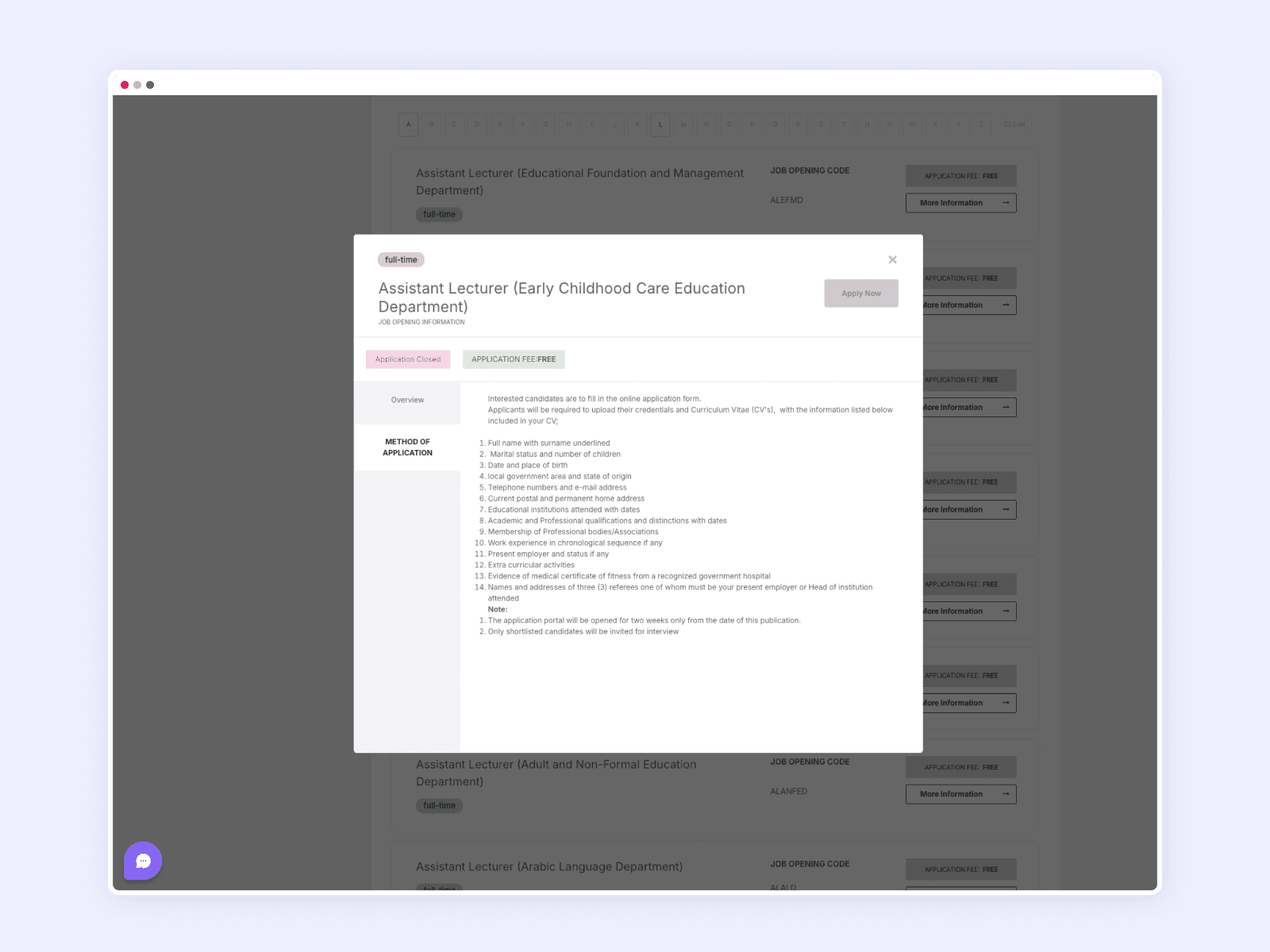



Ideation and concept Development.
Brainstorming Sessions
Held sessions with team members from development, and customer support.
Identified common pain points such as
Lengthy forms,
Repetitive questions,
Unclear instructions.
Generated ideas including
Modular forms,
Progress indicators,
Dynamic question flow based on user input.
Ideation and concept Development.
Brainstorming Sessions
Held sessions with team members from development, and customer support.
Identified common pain points such as
Lengthy forms,
Repetitive questions,
Unclear instructions.
Generated ideas including
Modular forms,
Progress indicators,
Dynamic question flow based on user input.
Ideation and concept Development.
Brainstorming Sessions
Held sessions with team members from development, and customer support.
Identified common pain points such as
Lengthy forms,
Repetitive questions,
Unclear instructions.
Generated ideas including
Modular forms,
Progress indicators,
Dynamic question flow based on user input.
Ideation and concept Development.
Brainstorming Sessions
Held sessions with team members from development, and customer support.
Identified common pain points such as
Lengthy forms,
Repetitive questions,
Unclear instructions.
Generated ideas including
Modular forms,
Progress indicators,
Dynamic question flow based on user input.



Concept Generation:
Modular Forms
Breaking the application form into smaller, manageable sections to avoid overwhelming users.
Progress Indicators
Including visual indicators to show users their progress and remaining steps.
Dynamic Question Flow
Adapting questions based on previous answers to make the form more relevant and concise.
Concept Generation:
Modular Forms
Breaking the application form into smaller, manageable sections to avoid overwhelming users.
Progress Indicators
Including visual indicators to show users their progress and remaining steps.
Dynamic Question Flow
Adapting questions based on previous answers to make the form more relevant and concise.
Concept Generation:
Modular Forms
Breaking the application form into smaller, manageable sections to avoid overwhelming users.
Progress Indicators
Including visual indicators to show users their progress and remaining steps.
Dynamic Question Flow
Adapting questions based on previous answers to make the form more relevant and concise.
Concept Generation:
Modular Forms
Breaking the application form into smaller, manageable sections to avoid overwhelming users.
Progress Indicators
Including visual indicators to show users their progress and remaining steps.
Dynamic Question Flow
Adapting questions based on previous answers to make the form more relevant and concise.
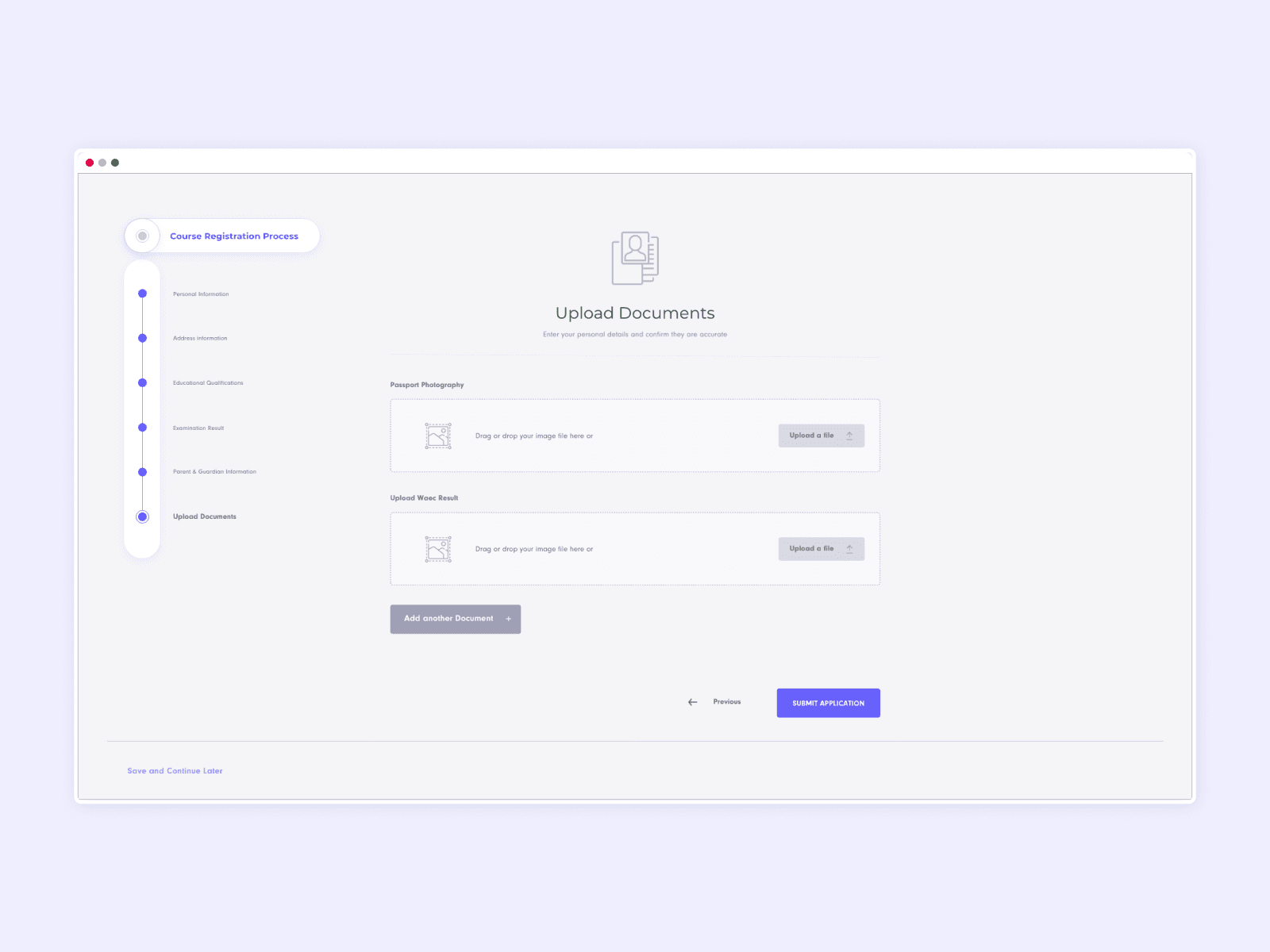


Prototyping
Developed a high-fidelity prototype incorporating modular forms, progress indicators, and dynamic question flow.
Designed prototype to be very interactive, allowing users to navigate through sections and see real-time feedback.
Validation and Testing:
Conducted usability tests with a group of 20 applicants from different demographics.
Collected feedback on the ease of use, clarity of instructions, and overall satisfaction.
Findings
85% of users found the modular form approach easier and less intimidating.
Progress indicators were praised for providing a clear sense of advancement.
Some users suggested further simplifying language and adding tooltips for additional help.
Prototyping
Developed a high-fidelity prototype incorporating modular forms, progress indicators, and dynamic question flow.
Designed prototype to be very interactive, allowing users to navigate through sections and see real-time feedback.
Validation and Testing:
Conducted usability tests with a group of 20 applicants from different demographics.
Collected feedback on the ease of use, clarity of instructions, and overall satisfaction.
Findings
85% of users found the modular form approach easier and less intimidating.
Progress indicators were praised for providing a clear sense of advancement.
Some users suggested further simplifying language and adding tooltips for additional help.
Prototyping
Developed a high-fidelity prototype incorporating modular forms, progress indicators, and dynamic question flow.
Designed prototype to be very interactive, allowing users to navigate through sections and see real-time feedback.
Validation and Testing:
Conducted usability tests with a group of 20 applicants from different demographics.
Collected feedback on the ease of use, clarity of instructions, and overall satisfaction.
Findings
85% of users found the modular form approach easier and less intimidating.
Progress indicators were praised for providing a clear sense of advancement.
Some users suggested further simplifying language and adding tooltips for additional help.
Prototyping
Developed a high-fidelity prototype incorporating modular forms, progress indicators, and dynamic question flow.
Designed prototype to be very interactive, allowing users to navigate through sections and see real-time feedback.
Validation and Testing:
Conducted usability tests with a group of 20 applicants from different demographics.
Collected feedback on the ease of use, clarity of instructions, and overall satisfaction.
Findings
85% of users found the modular form approach easier and less intimidating.
Progress indicators were praised for providing a clear sense of advancement.
Some users suggested further simplifying language and adding tooltips for additional help.



1st Iteration
Simplified language based on user feedback.
Added tooltips to provide additional guidance without cluttering the interface.
Refined the dynamic question flow to ensure it was seamless and intuitive.
Categorised the form to provide the user with the ability to fill each context/category at a time and to also save the form status and continue later.
2nd Iteration
Ability to display more information for the course before application.
An additional layer of verification is to ensure a student is qualified to apply for a course which is shortlisted by the Join Admission and Matriculation Board (JAMB) qualification exam (A Nigerian entrance examination board for tertiary-level institutions).
Discovered that 35% of the applicants visit cyber cafes to apply for desired courses so provided an accounting system where cafe administrators can apply to multiple candidates' accounts and track their progress.
1st Iteration
Simplified language based on user feedback.
Added tooltips to provide additional guidance without cluttering the interface.
Refined the dynamic question flow to ensure it was seamless and intuitive.
Categorised the form to provide the user with the ability to fill each context/category at a time and to also save the form status and continue later.
2nd Iteration
Ability to display more information for the course before application.
An additional layer of verification is to ensure a student is qualified to apply for a course which is shortlisted by the Join Admission and Matriculation Board (JAMB) qualification exam (A Nigerian entrance examination board for tertiary-level institutions).
Discovered that 35% of the applicants visit cyber cafes to apply for desired courses so provided an accounting system where cafe administrators can apply to multiple candidates' accounts and track their progress.
1st Iteration
Simplified language based on user feedback.
Added tooltips to provide additional guidance without cluttering the interface.
Refined the dynamic question flow to ensure it was seamless and intuitive.
Categorised the form to provide the user with the ability to fill each context/category at a time and to also save the form status and continue later.
2nd Iteration
Ability to display more information for the course before application.
An additional layer of verification is to ensure a student is qualified to apply for a course which is shortlisted by the Join Admission and Matriculation Board (JAMB) qualification exam (A Nigerian entrance examination board for tertiary-level institutions).
Discovered that 35% of the applicants visit cyber cafes to apply for desired courses so provided an accounting system where cafe administrators can apply to multiple candidates' accounts and track their progress.
1st Iteration
Simplified language based on user feedback.
Added tooltips to provide additional guidance without cluttering the interface.
Refined the dynamic question flow to ensure it was seamless and intuitive.
Categorised the form to provide the user with the ability to fill each context/category at a time and to also save the form status and continue later.
2nd Iteration
Ability to display more information for the course before application.
An additional layer of verification is to ensure a student is qualified to apply for a course which is shortlisted by the Join Admission and Matriculation Board (JAMB) qualification exam (A Nigerian entrance examination board for tertiary-level institutions).
Discovered that 35% of the applicants visit cyber cafes to apply for desired courses so provided an accounting system where cafe administrators can apply to multiple candidates' accounts and track their progress.
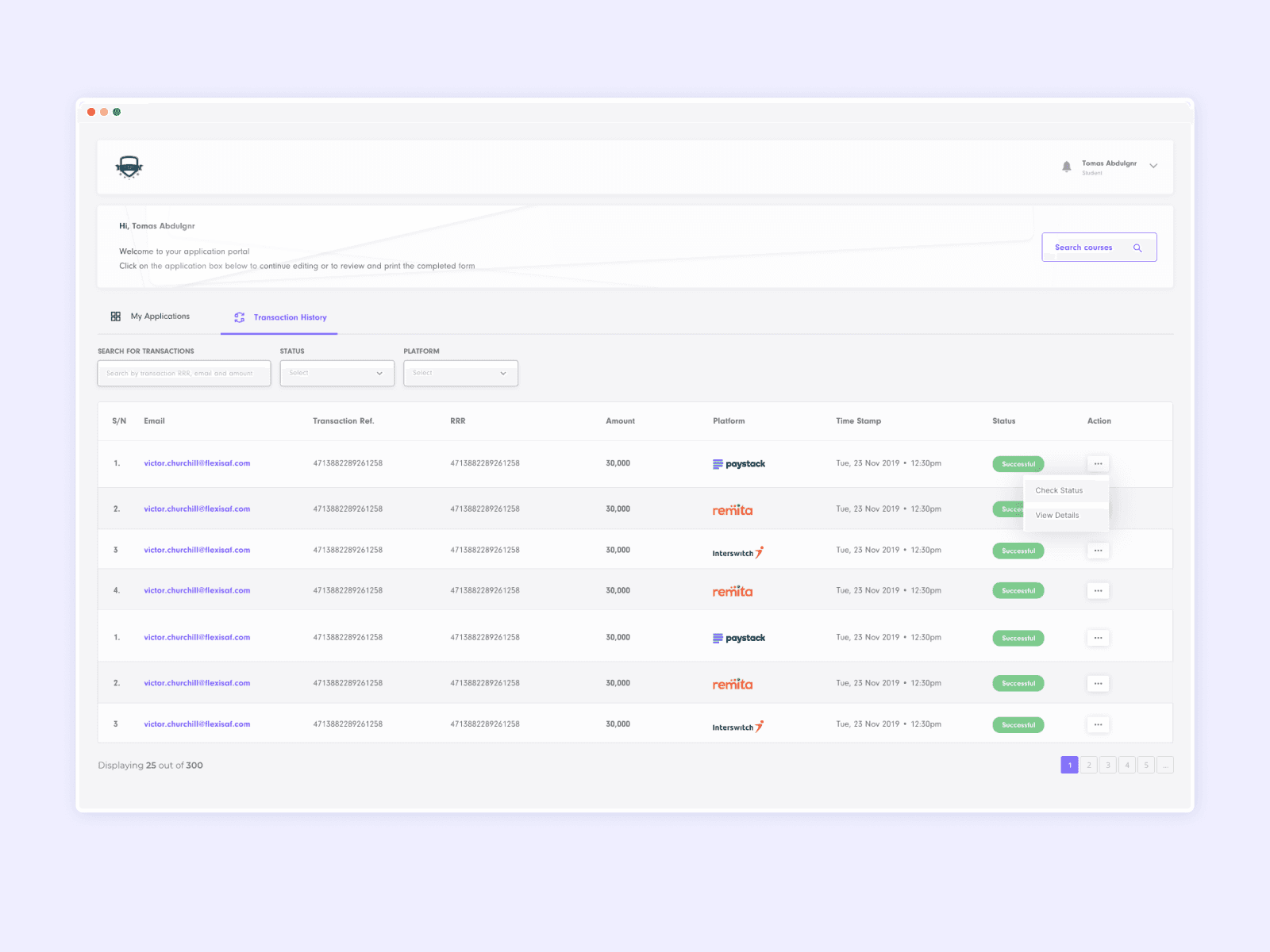


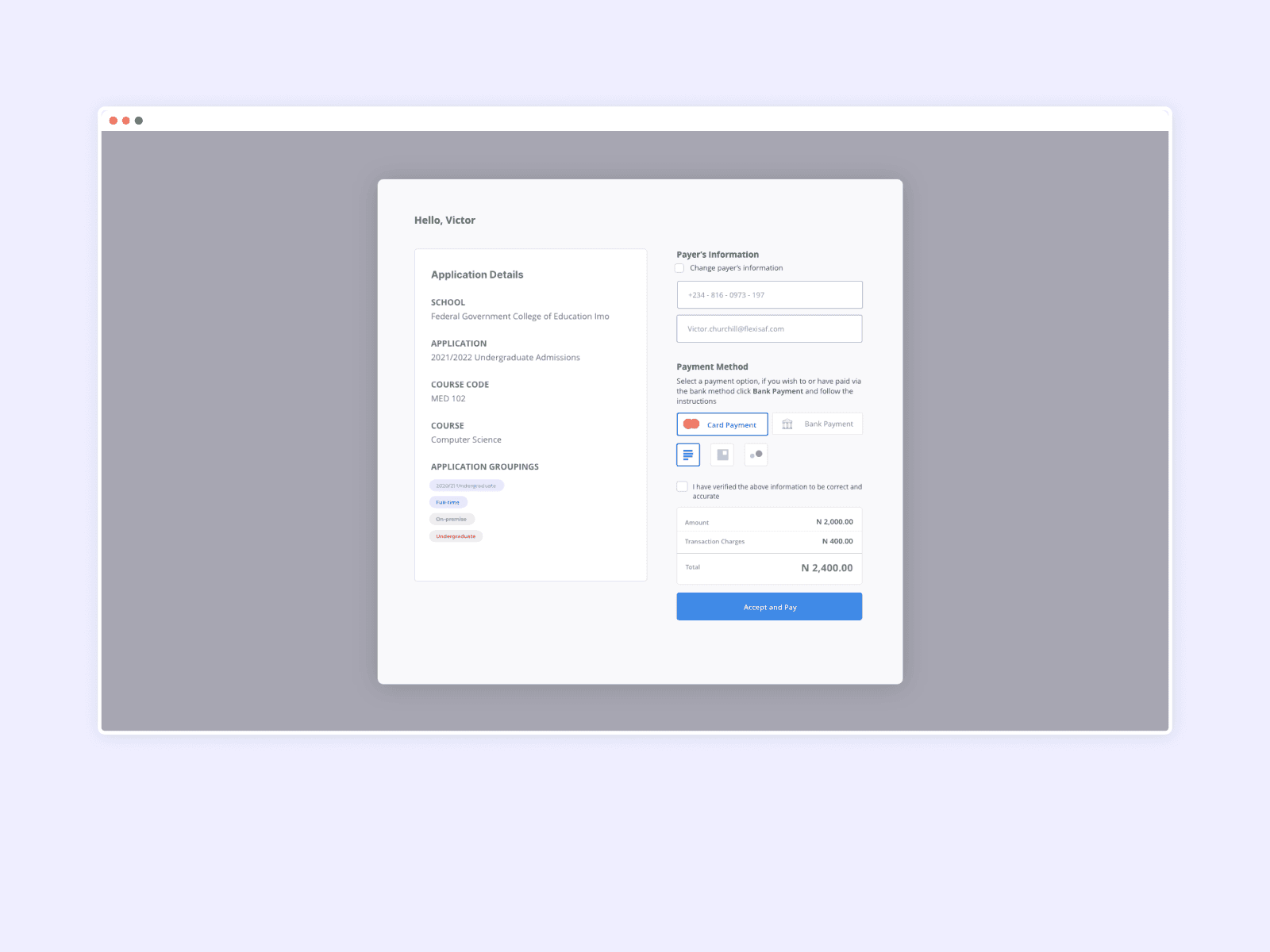


Conclusion
In conclusion, the SAFApplicant project not only succeeded in simplifying and enhancing the school application process but also provided invaluable insights into the needs and behaviours of our users. Through diligent research, innovative design, and continuous iteration, we were able to create a product that truly addresses the pain points for schools, applicants and parents. The success of SAFApply is reflected in the increased completion rates and positive user feedback we’ve received since its launch.
Lessons
This project was a significant learning experience, teaching us the importance of user-centred design and the power of iterative testing. Moving forward, we are excited to explore additional features and improvements that will further enhance the SAFApplicants experience. I am incredibly proud of the work our team has done and grateful for the opportunity to contribute to a solution that makes a real difference in the educational journey of so many families.
Finally, I would like to thank all the team members, stakeholders, and users who played a vital role in this project. Your collaboration, insights, and support were
Other Projects
I'm presently open to new creative endeavours, so if you believe I could be a great match for your team or venture, reach out, and let's transform your product concepts into reality.
Designed & developed by Victor Churchill. ©2023 All rights reserved
I'm presently open to new creative endeavours, so if you believe I could be a great match for your team or venture, reach out, and let's transform your product concepts into reality.
Designed & developed by Victor Churchill. ©2023 All rights reserved
I'm presently open to new creative endeavours, so if you believe I could be a great match for your team or venture, reach out, and let's transform your product concepts into reality.
Designed & developed by Victor Churchill. ©2023 All rights reserved
I'm presently open to new creative endeavours, so if you believe I could be a great match for your team or venture, reach out, and let's transform your product concepts into reality.
Designed & developed by Victor Churchill. ©2023 All rights reserved